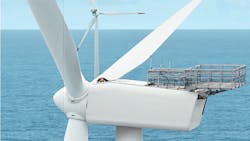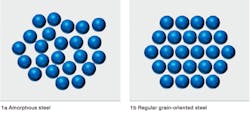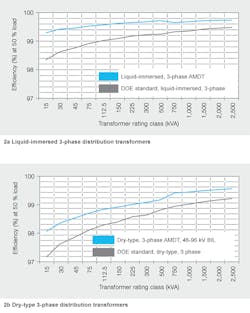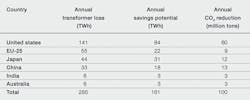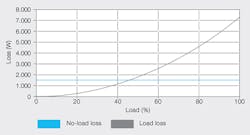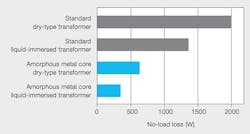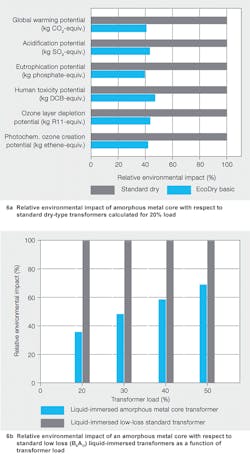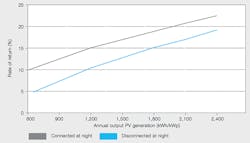As part of its green transformer portfolio for distribution transformers, ABB’s new amorphous metal technologies are helping to maximize energy savings. There are two types of amorphous metal distribution transformers (AMDTs):
- Liquid-immersed transformers with amorphous metal cores, with either conventional mineral oil, or vegetable oil- based liquids (BIOTEMP)
- EcoDry ultra-efficient dry-type transformers with amorphous metal cores Not only are there clear economical benefits to using amorphous metal core transformers, but there are environmental advantages as well.
Amorphous metal
The amorphous metal used by ABB is a metallic alloy of iron, boron and silicon (Fe-B-Si) produced by solidifying alloy melts at rates rapid enough to prevent crystallization of the metal [1]. Such rapid solidification leaves a vitrified solid with a random (amorphous) atomic structure, essentially as in the liquid phase ➔ 1. This differs from the atomic structure of conventional regular grain-oriented (RGO) silicon steel (a Fe-Si alloy), which has an organized crystalline structure. The largest volume usage of amorphous metal is in the cores of electrical distribution transformers. These materials offer, in concert, excellent magnetic characteristics and economy in production costs. In fact, the advent of Fe-B-Si amorphous metal alloys in the mid-1980s has been the most important advancement in materials for distribution transformers in the second half of the 20th century.
1 The disordered structure of amorphous steel and the ordered crystalline structure of regular grain-oriented steel
Solidification rates of 106 K/s are necessary to produce Fe-B-Si amorphous metals. The high heat extraction rates constrain the solid in the form of a thin ribbon, about 25 μm thick. Since the material is thin, the application of amorphous metal is restricted to wound transformer cores. Amorphous metal cores have been in use for over 20 years in liquid-filled transformers, and this technology is now being applied to drytype transformers.
Significantly lowered core losses
The most notable characteristic of an amorphous metal in a transformer is that it yields a much lower core loss than even the best grades of RGO steel, by up to 70 percent. In a transformer core material, there are two major types of losses: hysteresis loss and eddy current loss. The former reflects the ease of magnetization of the material when the core is energized, and the latter results from internal currents generated in the material. The absence of a crystalline structure in amorphous metal allows easy magnetization of the material, leading to lower hysteresis losses. The eddy current losses are also lower in amorphous metal due to a combination of its thinness and a high electrical resistivity of 130 μΩcm–1, compared with 50 μΩcm–1 in RGO steels.
Optimization via anneals
The low losses in amorphous metal are achieved through optimized anneals, ie, exposure to a temperature close to the material's Curie temperature (668 K) for a selected amount of time in the presence of an externally applied magnetic field. Annealing is an essential step for amorphous metals.
Magnetic anisotropy in a ferromagnetic material is a measure of the ease of magnetization away from a given direction. In RGO steels, the crystal structure primarily defines this anisotropy, whereby there are predefined easy axes for magnetization. The random atomic architecture in amorphous metals precludes such magnetocrystalline anisotropy. However, a magnetic anisotropy may be induced to define easy directions for magnetization in these materials. As a result of the very rapid cooling rates, amorphous metals have high quenching stresses, resulting in stress-induced anisotropy. With annealing, the quenching stresses are relaxed and by applying an external magnetic field of typically 1,000 A/m, a preferred axis of magnetization (along the ribbon length) is introduced in the material. A consequence of the anneal step is that the previously ductile amorphous metal becomes brittle, which requires more careful material handling in subsequent processing steps.
Lower design induction level
Due to the presence of boron, amorphous metal has a lower saturation induction (1.56 T) than RGO steels (2.1 T). Therefore, the design induction with amorphous metal is lower than that available from RGO steels. As a result, amorphous core transformers often have a larger core cross-sectional area, resulting in larger coils and transformer footprint. Transformer sound level Transformers with amorphous metal cores generate about 3 to 5 dB higher sound levels than those with RGO steel cores. Techniques to mitigate these higher sound levels are the focus of ongoing ABB research activities. Sound is generated within transformer cores due to an intrinsic characteristic of the core material called magnetostriction. When the magnetization direction has to rotate under an applied field, the material undergoes a dimensional change and sound is generated. In RGO steels, the crystalline axes for easy magnetization are well aligned between grains. This is not so in the case of amorphous metal, since the quenching stresses are never fully relaxed from annealing an amorphous metal. Therefore, during operation of a transformer, a greater degree of magnetization rotation is called for from amorphous metal than from RGO steels. The dimensional change is consequently higher, leading to greater sound levels.
Stable losses over time
In the 1990s it was shown that the performance stability of amorphous metal at the transformer operating temperature is very high and that significant changes in its loss performance would take more than 1,000 years [2]. Those aging tests were carried out with small toroids protected from oxygen. Since then, the composition of the amorphous metal alloy has changed slightly and manufacturing methods have been further developed. In order to guarantee the stability of today’s material (and to see the influence of an ambient air) ABB repeated accelerated aging measurements at high temperature (490 K) with a full-size core under air atmosphere for more than 200 days. But the results were similar, suggesting that no degradation of losses during the transformer lifetime needs to be expected.
Energy-savings potential
2 Comparison of US DOE mandated minimum efficiency standards across a wide range of transformer ratings
➔ 2 compares the efficiency of AMDT with the mandated minimum efficiency standards for the same by the US Department of Energy (DOE), across a wide range of transformer ratings. The improved energy efficiencies attained are quite clear. A quick back-of-the-envelope calculation may be used to highlight the energy savings potential from the deployment of AMDT. As mentioned, use of amorphous metal cores can reduce transformer core no-load losses by about 70 percent, when compared with RGO steel cores. Assuming that about 1 percent of the installed US generating capacity of 1.4 TW is lost in distribution transformer no-load losses, this reduction of losses from the use of amorphous cores suggests a potential annual energy savings of about 85 billion kWh.
The energy savings are sizable, even if only a fraction of all distribution transformers are replaced by AMDTs. This savings from existing generating capacity allows deferral or cancellation of plans for additional generation to meet ever-growing demand. The environmental benefits associated with reductions in noxious gas emissions and in the CO2 footprint are clear, as are the economical benefits accrued from energy and cost savings. The consequent social benefits are self-evident. Similar summary estimates for energy savings and CO2 reductions have been made for representative major nations [3], as presented in ➔ 3. If CO2 emissions are to be taxed by $25/ton, this amounts to $2.5 billion annually.
3 Annual energy savings potential and impact on CO2 generation from the use of AMDTs [3]
ABB's green transformers
The broad portfolio of ABB's green distribution transformers allows customers to select the most appropriate product to fit their needs. Some of the major criteria for product selection are the following.
4 N o-load and load loss components of a 630 kVA conventional dry-type transformer
Transformer losses
As in any transformer, the losses in amorphous metal transformers consist of two parts: the no-load loss (P0) generated in the core, and the load loss (Pk) mainly occurring in the transformer windings. P0 is always present and constant during normal operation, whereas Pk only occurs during transformer operation and is load dependent ➔ 4. The no-load loss of ABB's AMDT is only 30 percent of the no-load loss of a standard transformer ➔ 5. Thus, the use of an amorphous metal core could prevent the emission of 140,000 tons of CO2 – equivalent to 60,000 kg of oil – during an operation period of 20 years for a 1,000 kVA transformer.
5 Comparison of typical no-load loss values of standard and amorphous metal core liquid-immersed and dry-type 1,000 kVA transformers
Transformer costs
When selecting a transformer, a variety of costs may be considered: first costs, lifecycle costs, or costs including all additional infrastructure expenses. Life-cycle costs include capitalization of the transformer losses. This is usually done by using the TOC (total ownership cost) approach, in which specific valuations are assigned to P0 and Pk. These valuations, among other considerations, depend on the cost of electricity, on the cost of providing the lost power and on the utilization of the transformer. The values used by most utilities range between $5 and $10/W for P0 and between $1 and $2/W for Pk.
TOC = CT + A · P0+ B · Pk ($)
where TOC = total ownership cost, CT = transformer purchase price, A = capitalization factor for no-load loss, and B = capitalization factor for load loss.
AMDTs have a higher first cost. However, if life-cycle costs are considered, they are still the most economical choice.
Environmental sustainability and friendliness
ABB has done a comparative life-cycle assessment (LCA) for AMDT and RGO steel core transformers. LCA is an environmental management tool that is used to compare the potential environmental impact caused throughout the product life-cycle phases (ie, manufacturing, utilization, end-of-life) by different types of products or systems, with respect to several environmentally critical criteria.
As illustrated in ➔ 6, the environmental impact of the high efficiency AMDT is substantially lower than that of standard transformers. This lower impact is dominated by benefits during the use phase and the low no- load loss of the amorphous metal core.
6 Relative environmental impact of transformers
Green transformers in applications
The use of ABB's amorphous core transformers can have a significant impact on energy consumption in many different applications, such as utilities, wind power generation and photovoltaic power plants.
Transformers in the utility distribution grid
For utilities, the reduction of no-load loss is a major focus, since the average loading of a distribution transformer is generally low. AMDTs are the perfect choice to achieve this goal. Although first costs of AMDTs are higher, they are often the preferred choice if TOC is considered. This is shown in ➔ 7 for 1,000 kVA transformers having the no-load loss values depicted in ➔ 5 and with capitalization factors A = $10/W and B = $2/W. Additional cost savings may be achieved if dry-type transformers need to be actively cooled, or if CO2 taxation is considered.
7 Comparison of TOC (total ownership cost) of standard and amorphous metal core transformers
Transformers for wind power generation
Energy is produced from the turbines on a wind farm for only short periods throughout the day. Therefore, transformer no-load losses need to be minimized in wind power applications. As discussed above, the advantage of AMDTs in such applications becomes evident from TOC considerations.
EcoDry transformers for photovoltaic power plants
To promote solar energy, many countries have established a feed-in tariff system for electricity generated by photovoltaics (PV). For example, for a free-standing PV plant, which began operation in 2010, the tariff is 0.26 euros/kWh (about $0.34/kWh) in Germany and 0.32 euros/ kWh (about $0.42/kWh) in Spain. The operator of the PV plant wishes to maximize his income by maximizing the plant output and minimizing losses. A transformer in a PV power plant experiences a heavily varying load, depending on the time of day, the season and weather conditions. At night, the transformer consumes the no-load loss that the operator has to pay for, unless the transformer is disconnected from the grid. The dry-type EcoDry transformer is the ideal choice for such applications.
A simple model allows the calculation of the benefits. In the model, a certain number of sunny days per year is assumed, with a number of hours per day with an output of 95 percent and a number of hours with an output of 15 percent (morning and evening). The remaining days of the year are assumed to be cloudy and the output of the PV plant is 15 percent during the whole day. These conditions result in a certain specific annual output (kWh/kWp). For example, a specific output of 1,700 kWh/kWp is realized by having 240 sunny days with 6 hours at 95 percent load and 4 hours at 15 percent load.
If the price difference between the standard transformer, which has low first cost but high losses, and the EcoDry transformer is considered as an additional investment, the return on the investment can be calculated as shown in ➔ 8. Electricity costs of 0.08 euros/kWh (about $0.10/kWh) and revenues of 0.28 euros/kWh (about $0.37/kWh) are assumed in these calculations.
8 Return on investment for the additional costs of a high-efficiency EcoDry transformer in a photovoltaic installation
A clear choice
ABB's amorphous metal core technology for liquid-immersed and dry-type distribution transformers is a significant step toward improving energy efficiency. For customers, the selection of AMDTs requires no new considerations in the decision making process. The focus on energy efficiency and environmental sustainability, along with the cost competitiveness now available, make them an attractive choice.
V.R. Ramanan
ABB Corporate Research, Power Technologies
Raleigh, NC, United States
[email protected]
Martin Carlen
ABB Power Products, Transformers
Baden-Dättwil, Switzerland
[email protected]
---------------------
References
[1] Ramanan, V. R. V. (1991). Metallic glasses in distribution transformer applications: An update. Journal of Materials Engineering and Performance, 13(2), 119–127.
[2] Ramanan, V. R. V., Liebermann, H. H. (1993). Aging of glassy transformer core alloys and the activation energy spectrum model. Journal of Applied Physics, 73(10), 5366.
[3] European Copper Institute, Targosz, R. (Ed.). (2005, February). The potential for global energy savings from high efficiency distribution transformers.
